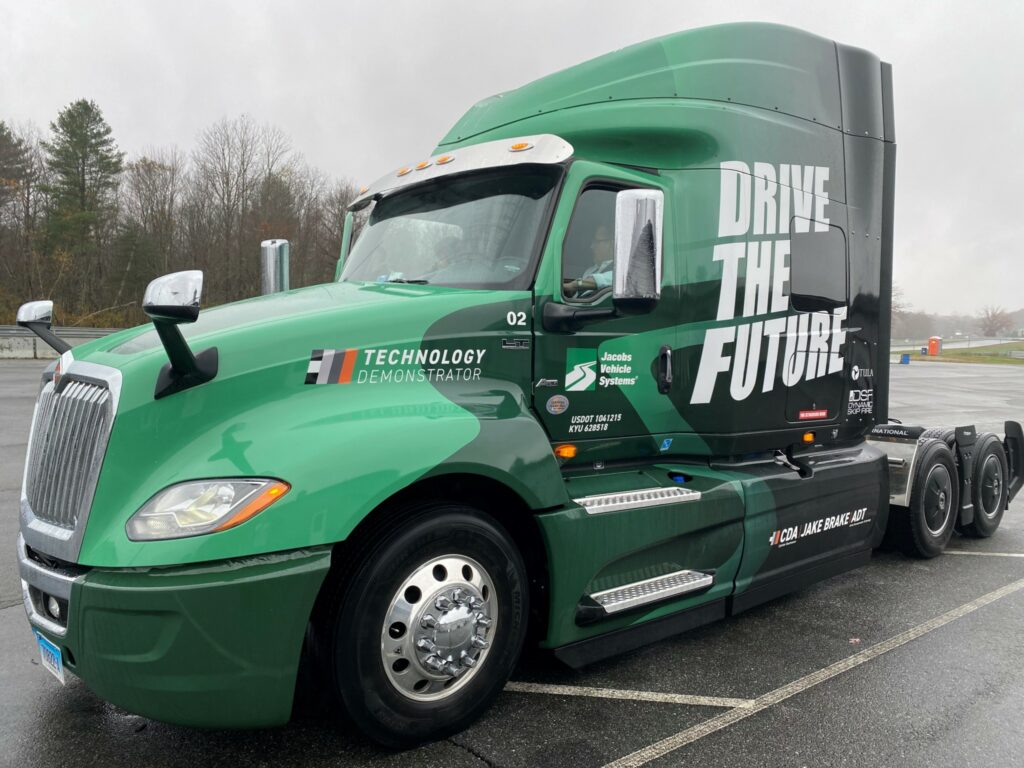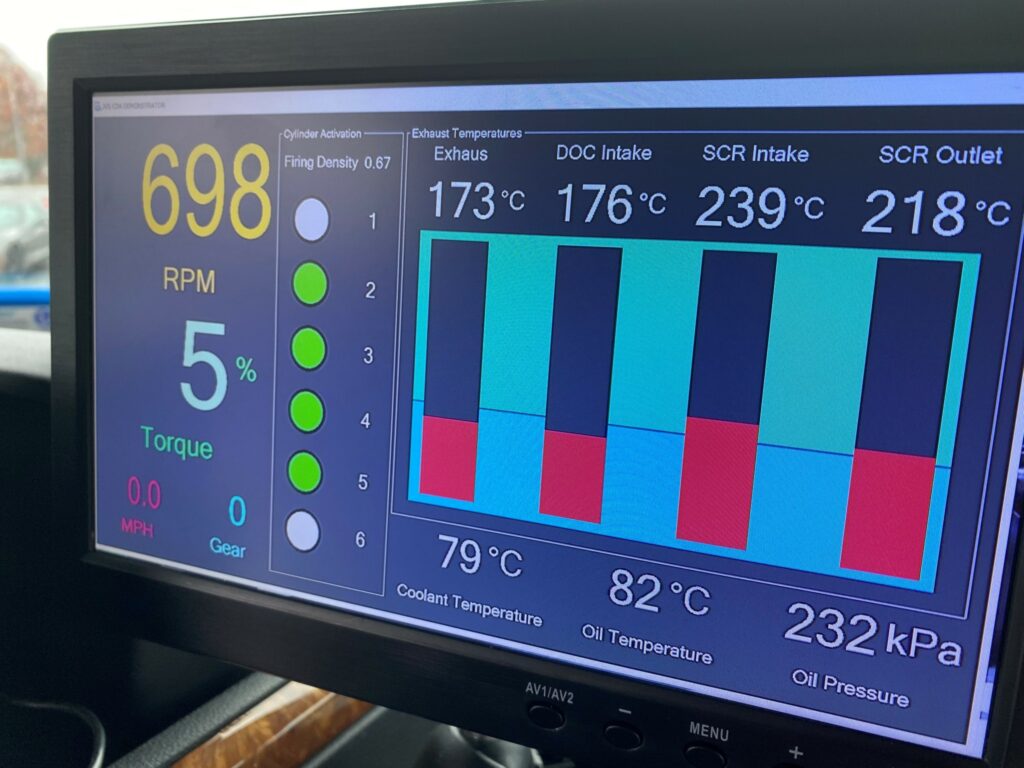Jacobs shifts beyond engine braking, develops emissions-reductions technologies
Nothing screams diesel power like the bark of a Jake brake. But the company behind that engine braking technology is rapidly evolving to ensure it remains relevant for many years to come — developing valvetrain technologies that will both lower emissions and slash fuel consumption.
Engine maker Cummins is convinced Jacobs has a role to play in the next generation of cleaner-burning engines, to the extent it purchased the company in February and has already begun investing heavily in Jacobs’ Bloomfield, Conn., plant where it is doubling production capabilities.
Jacobs, meanwhile, has built a demonstration truck to showcase its latest valvetrain technologies, cylinder deactivation (CDA) and active decompression technology (ADT). It’s a smart thing, too, since the magic happens well out of sight, deep within the engine, and the ultimate goal is to make the experience seamless to the driver.

The demo truck includes switches that can turn the CDA and ADT systems on or off, so drivers can experience both systems activated and deactivated under identical operating conditions in the same vehicle. An in-cab monitor, installed purely for demonstration purposes, shows the technologies work as intended, delivering the results seen from extensive lab testing and early stages of field validation work.
Jacobs’ CDA and ADT are designed to work with any engine brand, but the demonstration truck is an International LT625 tractor with an A26 diesel engine.
“We will be working with a wide variety of important commercial vehicle shareholders in the coming months to schedule test drives to demonstrate and showcase our latest technologies,” said Steve Ernest, vice-president – engineering and business development at Jacobs. Trucking trade press editors were among the first to experience the technologies during a Nov. 1 demonstration on a track near Jacobs’ Connecticut headquarters.
Cylinder deactivation
With the next round of federal EPA emissions standards in the late stages of development and set for Model Year 2027 implementation, cylinder deactivation is seen as a key enabler for engine OEMs to meet tighter NOx standards.
CDA converts a six-cylinder diesel engine into one that uses just four or fewer cylinders under the right operating conditions to reduce fuel consumption, but also to better maintain the optimal operating temperatures required to operate the exhaust aftertreatment in low-load and start-up conditions. Of course, burning less fuel also results in reduced CO2 output, so CDA takes a two-pronged approach to emissions reductions and compliance.
This solves an age-old problem. Raising aftertreatment temperatures to eliminate NOx traditionally meant increased fuel consumption and higher CO2 output.
When the load put on the diesel engine drops below a pre-determined threshold, selected cylinders are deactivated, improving fuel economy by up to 25% in some conditions. This also prevents cold air from entering the cylinders, improving selective catalytic reduction (SCR) performance to the tune of a 77% reduction in NOx, and slashing CO2 emissions 12%. While the technology has been used for years in the passenger car market, it has to be completely reinvented for commercial vehicle applications, officials explained.
Jacobs has tested it on 20 different heavy-duty engine platforms around the world, collecting more than 27,000 hours and 200,000 miles of durability testing. Most notably, it was demonstrated on the U.S. Department of Energy’s Super Truck II program with Navistar.
“As an ‘in-engine’ technology, CDA can add a small cost to engine production, but that cost can be mitigated by reducing the size and complexity of the aftertreatment system or eliminating the need for other technologies that reduce emissions,” Ernest explained. “Because CDA ultimately reduces fuel consumption and requires less maintenance than other external solutions designed to raise aftertreatment temperatures, it will result in a lower total cost of ownership.”
One of the challenges is to deactivate the cylinders without introducing harshness or vibrations noticeable from the driver’s seat. There’s no way to match the smoothness of six-cylinder operation – how the engine was designed to run – but I didn’t notice any additional vibrations when driving with cylinders deactivated.
If not for the screen installed in the cab for demonstration purposes, I wouldn’t have known anything had changed within the engine. As for the CDA’s ability to better maintain high operating temperatures within the cylinder for more efficient SCR operation, that too would have been invisible if not for that same screen.
Under low-load situations (we were bobtailing), with cylinder deactivation disabled, there was a sudden drop in exhaust, DOC intake, SCR intake, and SCR outlet temperatures, requiring the SCR system to work harder. With CDA enabled and cold air kept from entering the cylinders, higher exhaust temperatures were maintained for a longer period to improve SCR performance.
How effective is it? Independent testing showed that in low load cycles, CDA slashed NOx emissions by 86%, while CO2 and fuel consumption decreased by 12%. The demo truck, in unloaded local testing around town, has shown CDA to be active 49% of the time, with engine warm-up taking half the normal time and average SCR outlet temps increasing by 21.5 C. On-highway, pulling a trailer, CDA was active 22% of the time.
The greatest benefits will be seen in applications involving frequent starting and stopping, high idling, diminishing freight or empty return trips.
“No one runs full loads every single time they run down the road,” pointed out Robb Janak, director of new technology for Jacobs. “We are not claiming CDA is going to save a lot of fuel in high load conditions.”
For maximum results, CDA requires loads of less than 30%. “I want to see what the fleet can actually get, and that’s why we created this demonstration vehicle to get into the fleets,” Janak added.
Active decompression technology
ADT saves fuel in an entirely different manner, by taking the harshness out of engine starts and stops and making auto start/stop functionality seen in passenger cars more palatable to commercial vehicle drivers. It’s widely expected start/stop systems will be required to meet looming emissions standards, but the idea is cringeworthy to commercial truck drivers familiar with the harsh “death rattle” that comes anytime a diesel engine is powered down.
Fleet operators are also wary of the technology’s impact on starter motor, ring gear, and battery wear.
This cabin shake is greatly reduced using ADT, which can be integrated into multiple engine platforms. Jacobs says engine shake is reduced by 90% using ADT, and it would be hard to argue given the first-hand experience with the system activated and deactivated in the demonstration truck. An attractive side benefit is that drivers will be able to sleep better without harsh engine starts and shutdowns when using automated start/stops to maintain battery charge while idling during rest periods.

ADT keeps the engine valves open and the cylinders decompressed, so it coasts to a smooth shutdown. Upon start-up, the engine is kept in a decompressed state that decreases cranking torque by 40% and allows the engine to spin up to twice its normal speed for smoother starting. Wear on the starter gear, flywheel and other components is reduced, allowing for the use of smaller and lighter batteries, cables and starters, Jacobs says.
It also brings benefits to cold weather starts, by allowing the engine to be turned over while decompressed, enabling the engine to reach its critical compression ignition speeds. When combined with supplemental air inlet heaters, ADT pre-warms the cylinders without engine load from compression which reduces the battery charge levels.
“This was initially started as project that was requested of us to stop the driver from getting woken up when the engine was starting up at night to charge the hotel load batteries,” said Janak. “The shutdown would shake the driver out of bed. We solved that with this mechanism and got more requests: will it help with start-up? We kept evolving this to improve startability and shutdown, got rid of the shake, and also cut down wear.”
The hope is that the technology will allow for the use of automatic start/stop systems to reduce fuel consumption and emissions without aggravating the driver with the harsh vibrations normally associated with those starts and stops.
Both these technologies, well along the development path, will be marketed to engine OEMs in time for 2027 emission standards. Jacobs manufacturers its own valvetrain systems, which are then shipped to the engine OE for integration and installation on its own production lines.
Janak told TruckNews.com that engine OEMs are still waiting for EPA to say exactly will be required for the 2027 Model Year emissions reductions, but that CDA and ADT will be ready to help them meet those targets when necessary.
Have your say
This is a moderated forum. Comments will no longer be published unless they are accompanied by a first and last name and a verifiable email address. (Today's Trucking will not publish or share the email address.) Profane language and content deemed to be libelous, racist, or threatening in nature will not be published under any circumstances.
Dear Mr. Menzies,
This is an excellent article on Jacobs newest Valve Technology “CDA”, which I’m familiar with. Do you know if they’ve encountered the excessive oil usage issue that some of the automotive gas engines have experienced with CDA type methods? Please see Patent # US11,421,565 “Control System and Method to Mitigate Reverse Oil Flow to the Combustion Chamber on Deactivated Cylinders”. This may offer a fix that does not interfere with their CDA technology.
Michael J. Holihan-Principal Engineer
Woodstock, Georgia